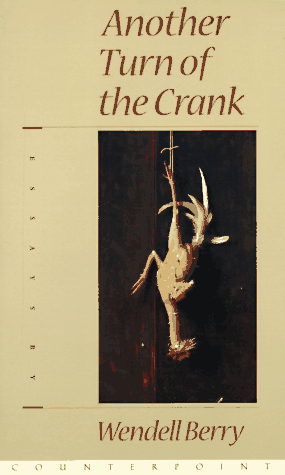 |
Home |
Catalogs |
Contact Us |

Books on:
Animal RightsBlack History
Clean Energy
Democracy
Eco Design
Eco History
Food and Nutrition
Genetic Engineering
Green Cities
Green Politics
Local Economics
Natural Building
Peace and Nonviolence
Simple Living
Trees and Forests
 |
Another Turn of the Crank
by Wendell Berry
Counterpoint, 1996
Purchase
on Amazon.com
The six essays in Another Turn of the Crank address the value of communities and the ways in which we can strengthen them.
Praise for Another Turn of the Crank
"A Kentucky farmer and writer, and perhaps the great moral essayist of our day, Berry has produced one of his shortest but also most powerful volumes." --New York Review of Books
"His advocacy of local communities is not the result of a nostalgic longing for a former place and time, but of the hunger for an environment in which human beings are most fully human."-- Washington Post
Quotes from Another Turn of the Crank
"Nothing I have written here should be construed as an endorsement of either of our political parties. . . . One reason for this is that I am an agrarian. I think that good farming is a high and difficult art, that it is indispensable and that it cannot be accomplished except under certain conditions. . . . Another reason is that I am a member, by choice, of a local community, and I know that our communities are disintegrating under the influence of economic assumptions that are accepted without question by both our parties--despite their lipservice to various noneconomic 'values'."
"The survival of farmers, then, depends upon two complementary efforts. The first is entirely up to the farmers, who must learn--or learn again--to farm in ways that minimize their dependence on industrial supplies. They must diversify, using both plants and animals. They must produce, on their farms, as much of the required fertility and energy as they can. So far as they can, they must replace purchased goods and services with natural health and diversity and with their own intelligence. . . . If farmers do not wish to cooperate any longer in their own destruction, then they will have to reduce their dependence on those global economic forces that intend and approve and profit from the destruction of farmers, and they will have to increase their dependence on local nature and local intelligence.
"The second effort involves cooperation between local farmers and local consumers. If farmers hope to exercise any control over their markets, in a time when a global economy and global transportation make it possible for the products of any region to be undersold by the products of any other region, then they will have to look to local markets. The long broken connections between towns and cities and their surrounding landscapes will have to be restored."
"The case of The Kentucky Cycle, which won a Pulitzer Prize, is of more than local interest, because Mr. Schenkkan's plays are representative of a sort of one-eyed, politically correct criticism of American history and of Western cultural tradition that is a danger both to understanding and the possibility of improvement. Mr. Schenkkan is at fault in his play and in what he has said about it not because his history is wrong, for he is right about our inheritance of greed and destruction, but because it is incomplete. It has become too easy to suppose that American history has been entirely determined by the experience of the frontier, and moreover that our frontier experience was determined entirely by arrogance, violence and greed."
"We certainly have no better student [than Wallace Stegner] of the workings of our frontier irresponsibility. Wallace Stegner was born into the failed and still-failing frontier dream of easy wealth and easy escape that motivated the both the westward movement of the frontier and the industrialization that followed. He recognized the powerful influence of this myth on his father, who "wanted to make a killing and end up on Easy Street" but who was driven, first by hope, and then by failure, from one money-making scheme to another, and finally to ruin. This . . . was actually less a myth than a mental condition that Stegner described as 'exaggerated, uninformed, unrealistic, greedy expectation.' In his own early experience, this expectation led to the plowing of the prairie in southwestern Saskatchewan--prairie that was 'totally unsuited to be plowed up.' The same expectation led to the settlement of the American West on the basis not of sound local knowledge but of presumption and pipe dream."
In his later books, Stegner gives much attention and no little grief to the results, human and natural, of the 'feeding frenzy' that inevitably accompanied the entrance of an uninformed and limitless greed into a land that was both abundant and fragile.
"But unlike many recent commentators on our history, Stegner knew also that as a people, we were not conditioned entirely by the inordinate desires and acts of the boomers. There was, virtually from the beginning, a counter theme, the theme of settlement, which always implied the 'myths of preservation and responsibility' that Mr. Schenkkan talks about. . . . Not all who came to American places came to plunder and run. Some came to stay, or came with the hope of staying. These Stegner called 'stickers' or 'nesters.' They were moved by an articulate hope, already ancient by the time of Columbus, of a settled, independent, frugal life on a small freehold."
"If enough of us were to choose caring over not caring, staying over going, then the culture would change, the theme of exploitation would become subordinate to the theme of settlement, and the choice to be a sticker would become easier. The necessary examples would be more numerous and more available. The way would be clearer."
"To assure myself that what I have described as a good forest economy is a real possibility, I went to visit the tribal forest of the Menominee Indians in northern Wisconsin. . . . The Menominee originally inhabited a territory of perhaps ten million acres in Wisconsin and northern Michigan. By the middle of the nineteenth century, as the country was taken up by white settlers, the tribal holding had been reduced to 235,000 acres, 220,000 acres of which were forested.
"The leaders understood that if the Menominee were to live, they would have to give up their old life of hunting and gathering and make timber from their forest a major staple of their livelihood; they understood also that if the Menominee were to survive as a people, they would have to preserve the forest while they lived from it. And so in 1854 they started logging, having first instituted measures to ensure that neither the original nature nor the productive capacity of the forest would be destroyed by their work. Now, 140 years later, Menominee forest management has become technically sophisticated, but it is still rooted in cultural tradition, and its goal has remained exactly the same: to preserve the identification of the human community with the forest, and to give an absolute priority to the forest's ecological integrity. The result in comparison to the all-too-common results of land use in the United States, is astonishing. In 1854, when logging was begun, the forest contained an estimated billion and a half board feet of standing timber. No records exist for the first thirteen years, but from 1865 to 1988 the forest yielded two billion board feet. And today, after 140 years of continuous logging, the forest still is believed to contain a billion and a half board feet of standing timber. Over those 140 years, the average diameter of the trees has been reduced by only one half of one inch--and that by design, for the foresters want fewer large hemlocks.
"About 20 percent of the forest is managed in even-aged stands of aspen and jack pine, which are harvested by clearcutting and which regenerate naturally. The rest of the forest is divided into 109 compartments, to each of which the foresters return every fifteen years to select trees for cutting. Their rule is to cut the worst and leave the best. That is, the loggers remove only those trees that are unlikely to survive for another fifteen years, those that are stunted or otherwise defective, and those that need to be removed in order to improve the stand. Old trees that are healthy and still growing are left uncut. As a result, this is an old forest, containing, for example, 350-year-old hemlocks, as well as cedars that are probably older. The average age of harvested maples is 140 to 180 years."
Table of Contents of Another Turn of the Crank
- Farming and the Global Economy
- Conserving Communities
- Conserving Forest Communities
- Private Property and the Common Wealth
- The Conservation of Nature and the Preservation of Humanity
- Health is Membership
Reader Comments |
